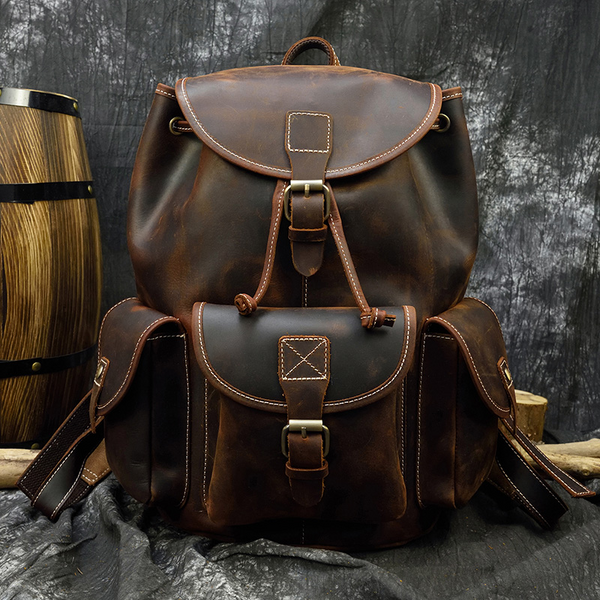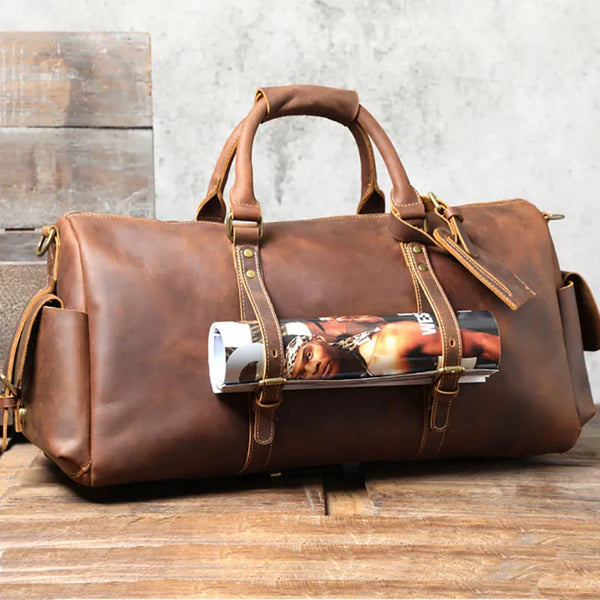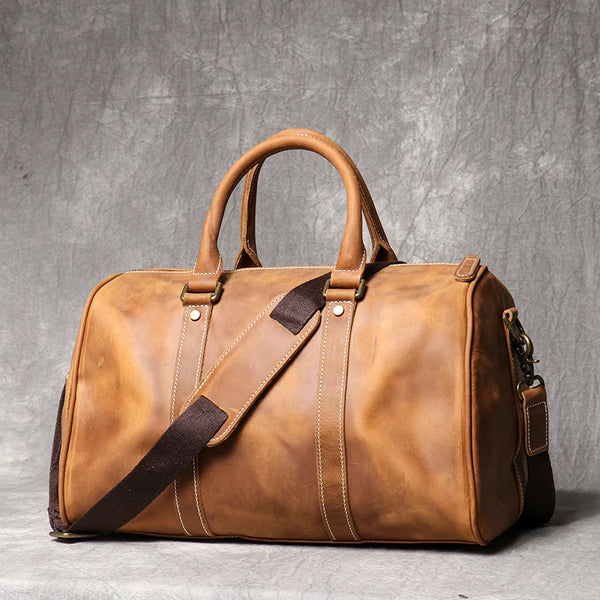Types of waterproof sprays and how to use them
Points to consider when choosing the best spray for leather products and how to use it effectively
To make your precious leather products last longer,Waterproof sprayIt is essential to use. However, not all waterproof sprays are suitable for leather products, and some types of sprays can damage the leather. In this article, we will explain the types of waterproof sprays, scientific differences, and key points to use from a professional perspective, and explain how to choose the best waterproof spray for leather products.
Related Products
Crazy Horse Leather Backpack_B
It can also be used as a backpack for outdoor activities such as camping and hiking.

table of contents
- Main types of waterproof sprays and their differences
- Scientific Waterproofing Mechanism: The Difference Between Water Repellent and Waterproofing
- Effective use of waterproof spray
- How to choose a waterproof spray and what to be careful about
- FAQ: Frequently Asked Questions about Waterproof Spray
Main types of waterproof sprays and their differences
There are many different types of waterproof sprays, and it is important to choose the right one for each application and material. Here we will explain the types and features of common waterproof sprays.
1. Silicone waterproof spray
Silicone waterproof sprays have a strong waterproof effect and are often used in fabric and outdoor products. but,Not necessarily suitable for leather products. Silicone can impair the breathability of the leather, which can change the texture and texture of the leather.
Also, silicon spray creates a film on the surface of leather.A type of leather that you can enjoy aging(example:Crazy Horse Leather) should be avoided in particular. Silicone sprays are not recommended for leather as they may damage the natural texture of the leather and its age.
2. Fluorine-based waterproof spray
Fluorine waterproof sprays areA very suitable option for leather productsis. It uses a fluorine compound, and while maintaining breathability, it has the effect of repelling water and dirt strongly. It repels water and dirt, but does not damage the texture of the leather, and is widely used in leather bags, shoes, belts, etc.
Fluorine-based sprays are especially suitable for outdoor use and waterproofing on rainy days.Genuine leather productsEven when used in the product, fluorine-based sprays can be expected to protect the leather while maintaining its beauty.
3. Waterproof spray made from natural ingredients
Waterproof spray made from natural ingredientsis a chemical-free and environmentally friendly option. It uses beeswax and vegetable oils and is leather-friendly, so it is recommended for those who are sensitive to synthetic chemicals or who want to place importance on environmental considerations.
However, natural ingredients sprays areWater repellent effect is slightly inferior to silicon and fluorine.It may happen. Therefore, regular reapply is required, but it is suitable for those who want to achieve waterproofing while protecting the texture of the leather.
4. Nanotechnology waterproof spray
The waterproof spray using nanotechnology penetrates deep into the leather fibers,High waterproof effectand has durability. The fine waterproof particles cover the surface of the leather, preventing moisture and dirt for a long period of time.
Nano sprays are especially ideal for expensive leather products and outdoor gear.Crazy Horse LeatherBy using it on high-end genuine leather products, it is waterproof while maintaining the texture and breathability of the leather.
Scientific Waterproofing Mechanism: The Difference Between Water Repellent and Waterproofing
When choosing a waterproof spray, it is important to understand the difference between "water-repellent" and "water-resistant." These tend to appear similar, but scientifically they work in different mechanisms.
What is water repellent?
Water repellentThis refers to a condition in which water is less likely to adhere to the surface of the material. The water-repellent material is characterized by its ability to repel water while still maintaining breathability. Water-repellent sprays are often used in leather products, shoes and jackets, and are effective in protecting the material from everyday rain and dirt.
for example,PU leather productsBy using a water-repellent spray, if water droplets form on the surface, they will not seep in, leaving them flowing off, preventing dirt and damage caused by water.
What is waterproof?
on the other hand,waterproofThis refers to a process that completely prevents water from penetrating inside the material. Waterproof spray prevents water from entering into leather and fibers, making it highly effective against heavy rain and water.
The waterproof spray is suitable for use in normal rainy weather and outdoors.Products that can be exposed to long-term wet environmentsIdeally use it for. However, fully waterproofing can damage breathability, so leather products require a proper balance.
Effective use of waterproof spray
To effectively use waterproof sprays, it is important to understand the correct usage. Below are the specific steps:
1. Wipe off surface dirt before use
Before using a waterproof spray, lightly wipe off any dust and dirt from the surface of your leather product with a soft cloth. If you use a spray with dirt still remaining, the dirt may become solidified.
2. Use in a well-ventilated area
Make sure to use waterproof spray in a well-ventilated area. The spray mist is floating in the air, so it may inhal in areas with inadequate ventilation. In addition, we recommend drying it in a cool place away from direct sunlight to ensure that it dries thoroughly after spraying.
3. Spray from an appropriate distance
When using spray, use leather products.A distance of about 20-30cmThe key is to spray evenly. If it's too close, it can easily cause unevenness, and if it's too far, it can be less effective. Apply evenly across the product to ensure that the spray is evenly distributed.
4. Dry before use
After spraying, leave it for a few hours until it is completely dry. If used in a damp state, it not only weakens the effect, but it can also cause stains on the leather. Dry thoroughly to maximize waterproofing.
How to choose a waterproof spray and what to be careful about
When choosing a waterproof spray,Products that match the materialIt is important to choose. Fluorine-based and nanotechnology waterproof sprays are generally suitable for leather products, but special sprays should be used for suede and nubuck.
1. Choose the right spray for your material
Choose the right spray depending on the type of leather and the product's purpose.Crazy Horse LeatherFor rare leather products like this, sprays with high water-repellent properties are ideal. Also, colored leather products includeColorless transparent sprayIt's safe to choose.
2. Beware of the spray ingredients
Items containing chemical ingredients, such as fluorine-based sprays, can affect leather products, so be sure to test them in an inconspicuous area. In particular, when choosing natural ingredients, this is recommended for those who value environmental considerations and kindness to leather.
3. Reapply regularly
The effect of waterproof sprays is not permanent. The effect will fade depending on the frequency of use and the environment,Once every 1-2 monthsRe-applying is recommended. Especially if you use it frequently on rainy days or outdoors, spraying frequently can help your product last longer.
FAQ: Frequently Asked Questions about Waterproof Spray
Q1. Does using waterproof spray change the texture of the leather?
Fluorine-based and nanotechnology waterproof sprays rarely cause major changes to the texture of the leather even after use. however,Silicone sprayUse should be thought carefully as it can impair the breathability of the leather.
Q2. Can I use waterproof spray on suede and nubuck?
Yes, suede and nubuck have their own waterproof spray. These materials are very delicate, so use a special spray to make it easier to use.Prevents moisture and dirtIt is effective.
Q3. How often should I reapply a waterproof spray?
Depending on the frequency of use and environment of leather products,Once every 1-2 monthsRe-applying is recommended. Especially if you use it frequently on rainy days or outdoors, spraying it frequently can help maintain the waterproofing effect.
Q4. Is there anything I should be careful about before using a waterproof spray?
Before using a waterproof spray, thoroughly wipe off the surface of the leather product to remove any dirt. We also tested the area inconspicuously,Check that the leather color and texture are not changedIt's also important to do so.
Recommended products from cowmono
Related Products
Crazy Horse Leather Large Capacity Travel Bag_K
Although its appearance is simple, the plain design brings out the unique texture of cowhide. You can feel the warmth and feel of natural leather, which is accompanied by the deepening attachment that comes with use. The zippered opening and closing part is easy to use, and there are convenient pockets inside and outside, making it useful not only for travel but also for business situations.

Crazy Horse Leather Travel Bag_A
For those looking for elegance and toughness as a travel companion, accessories to add color to everyday life, this 100% genuine cowhide crazy horse leather travel bag

If you are looking for high-quality leather products, please take a look at the following products from cowmono:
Author information

Author name: Yama (cowmono Owner)
Occupation: Slowth Lab Representative
He is engaged in sales and marketing for apparel companies both in Japan and abroad over quarterly. He has a deep knowledge of fashion, sports, outdoor activities, and subculture.